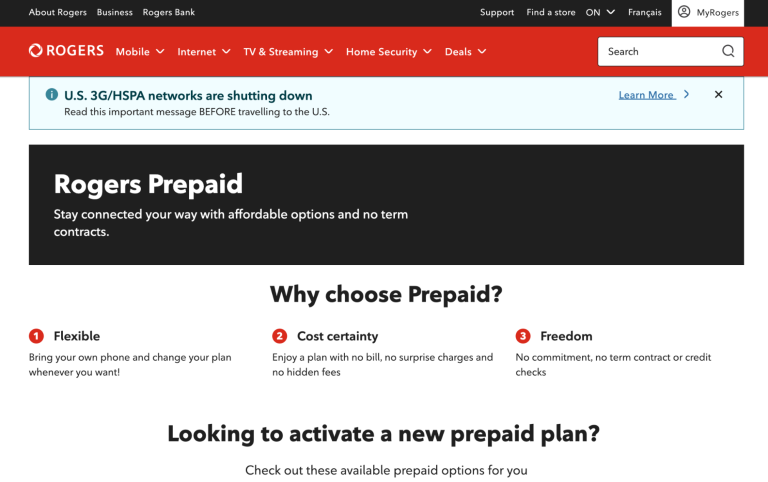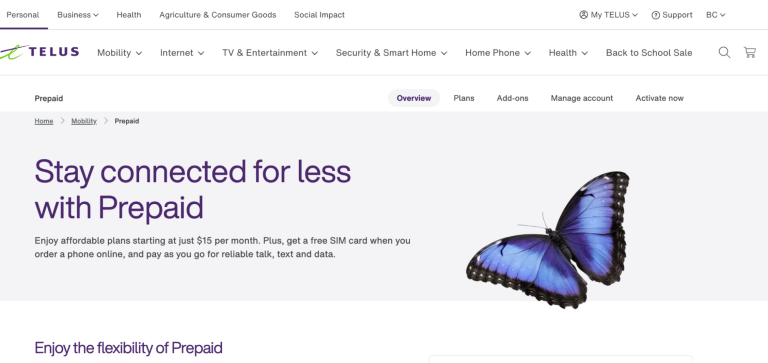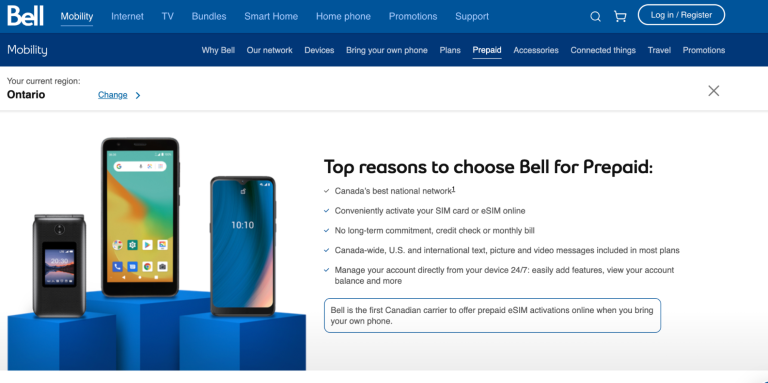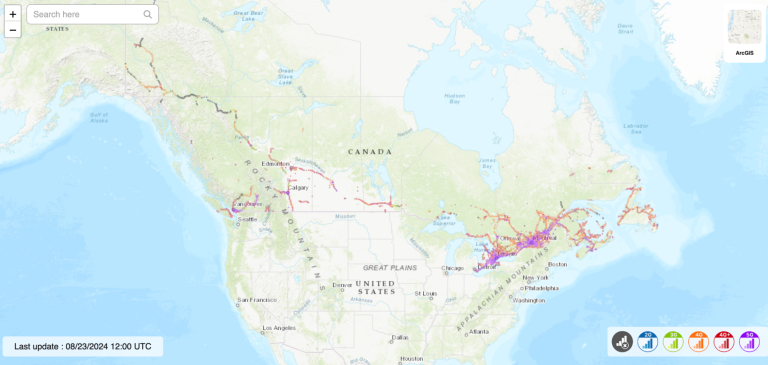How to get mobile internet in Canada: Ultimate guide
Wondering how to get mobile internet in Canada? Whether you’re a foodie headed to Toronto, a music lover ready for Montreal, or a road tripper traveling by trailer, we’ve put together this guide to help you find the best mobile internet in Canada.
If your next destination is the land of frost and fun and you haven’t figured out how you’re going to get mobile internet in Canada yet, you’re in the right place. To make your trip sweet as maple, you’re going to need a travel internet provider you can trust.
By the end of this article, you’ll be flying to Canada knowing you can find that unforgettable restaurant, hail an Uber, or use Google Maps without worrying about a hefty phone bill upon your return.
There are a number of ways you can stay connected and use your phone in Canada. In this guide, we cover all of your options: from roaming, to public and Pocket WiFi, to electronic and physical SIM cards. Let’s head North!
How to get mobile internet in Canada
So you’ve checked your Canada travel guide, made your plans, and maybe even booked your tickets. Now, how to get internet in Canada? How to get data in Canada? Wait, there’s a difference between the two!? Read on.
There are many ways to connect to the internet during your trip. Here are your options:
1. Grab an eSIM card for Canada
The eSIM is the digital version of the traditional, physical SIM card we all know—and perhaps don’t love.
It works thanks to a pre-installed device on your mobile phone that lets you install eSIM profiles. Think of it as changing your phone’s brain chip before you visit.
With an eSIM, you still get to keep your same physical phone, but you change the communication system. All totally remote.
Most eSIM cards work in collaboration with local cell service and mobile internet providers. This gives users access to local networks without lengthy service agreements.
For example, Holafly works with Rogers, the largest and most reliable 5G network in Canada, providing Holafly customers with secure and stable connection like the locals.
There’s no physical installation, no loss or change of contacts, phone numbers, or photos! The eSIM simply allows your phone to communicate with a new part of the world.
To use an eSIM you just need to scan a QR code and can start activating your new plan. Once your eSIM is activated, you can use your phone as soon as you land and start messaging, streaming, and saving your go-to coffee shops on maps as if nothing changed at all.
To figure out the best eSIM provider for your trip, check out the best eSIMs for Canada. Don’t leave messaging your loved ones to chance with spotty WiFi!
Consider the Holafly eSIM for Canada
A favorite eSIM provider for Canada is Holafly. To purchase an eSIM online with Holafly, you just need to visit the website, select the number of days you’ll be North-bound, and complete the purchase process.
Your Holafly eSIM for Canada has the following perks:
- High-speed connection across Canada including Toronto, Quebec, Vancouver, and other major cities by connecting to the best Canadian carrier networks.
- No assembly, registrations, subscriptions or ID needed to set up.
- Unlimited data plans (that means unlimited internet access).
- Up to 500 MBs to 1 GB of data sharing available per day.
- Connect immediately with a QR code.
- Keep your WhatsApp number.
Holafly’s eSIM for Canada offers unlimited data for a specified period, creating a custom fit and eliminating additional roaming charges.
To compare prices of the different eSIM plans, see the table below with some of the plans prices:
| Days of use | Mobile data | Price (USD) | Price per day (USD) |
| 1 | Unlimited | $7.90 | $7.90 |
| 5 | Unlimited | $29.90 | $5.98 |
| 10 | Unlimited | $39.90 | $3.99 |
| 30 | Unlimited | $93.90 | $3.13 |
| 90 | Unlimited | $288.90 | $3.21 |
On the other hand, if your plan in Canada is to stay for a long time to explore its wonders, Holafly offers three monthly subscription plans (unlimited data, 25 GB, or 10 GB) with coverage in 170+ countries and hotspot available with two of the plans. Save money while staying connected to a reliable internet.
Check our plans, select the ideal one for you, and activate it in minutes. Easy peasy!
That’s your best eSIM option on the table. Ready to explore some other ways you can get internet in Canada? Read on!
2. Consider one of the best prepaid Canadian SIM cards

With a Canada SIM card you can enjoy top-quality internet access, wireless coverage, and share data with other devices. This will be more likely if you buy your SIM card from a Canadian SIM carrier—which can prove a little tricky if you’re flying in from overseas.
You’ll have to choose, and pay for, the best delivery option for you. Order with plenty of time to avoid missing your SIM card altogether.
You also have the responsibility of storing your original SIM in a safe location for your trip duration. Write that place down—we know we’re not alone at failing to remember that “ultra safe spot” in our luggage.
Psst. An eSIM eliminates the stress of changing and storing cards while you’re supposed to be enjoying your vacation.
If you do decide on going for a local, physical SIM card, here are a few of the main providers and what they have to offer.
Rogers prepaid SIM card
Rogers, one of the most important operators in Canada, offers a prepaid physical SIM card in collaboration with chatr Mobile, starting at $15 USD per month. This includes:
- 100 minutes of phone calls within Canada
- Unlimited texts within Canada and the US
- 250 MB with AutoPay

There is also a Rogers Prepaid card for $100 USD per year if you intend to travel for an extended period of time. This includes:
- 400 anytime local minutes
- 400 texts within Canada
Note: If you’re looking to solve the question of how to get data in Canada, particularly for a short trip, this is not your plan. There is no data coverage included and it extends over a year.
Otherwise, Roger’s offers monthly plans for existing customers starting at $15 USD per month with no data included and increasing up to $55 USD per month and 8 GB of data.
Here are those figures:
- $15 USD per month: 100 minutes Canada-wide calls, unlimited texts
- $25 USD per month: Unlimited Canada-wide calls, unlimited texts
- $30 USD per month: 500 MB of data, unlimited Canada-wide talk, unlimited texts
- $40 USD per month: 2.5 GB of data, unlimited Canada-wide talk, unlimited texts
- $45 USD per month: 4.5 GB of data, unlimited Canada-wide talk, unlimited texts
- $55 USD per month: 8 GB of data, unlimited Canada-wide talk, unlimited texts
You can visit a Rogers store in person to purchase a physical SIM and activate a plan, or visit their website. Customers are generally satisfied with service, locals and travelers alike.
As Canada’s leading wireless, media, and cable company, most people in Canada would say it is a well-known and trusted provider.
Telus Prepaid SIM card
The next largest operator in the country, Telus, offers five monthly plans to stay connected to the internet. Telus also provides free local calls and SMS along with mobile data.

Here are the plans Telus has to offer for internet access in Canada:
- $15 USD per month: 100 minutes of Canada-wide calls, unlimited texts
- $25 USD per month: Unlimited Canada-wide calls, unlimited texts
- $35 USD per month: 1GB of data, unlimited Canada-wide calls, unlimited texts
- $45 USD per month: 5GB of data, unlimited Canada-wide calls, unlimited texts
- $55 USD per month: 10GB of data, unlimited Canada-wide calls, unlimited texts
It’s important to choose your plan wisely, as additional usage fees apply. Here are the details:
- $0.15 USD per MB of data usage
- $0.15 USD per minute on local calls
- $0.50 USD per text message
Tellus is also known for its wide coverage across Canada. It’s said to be more dependable in rural areas and cover almost the entire Canadian population.
If you’re looking for coverage by a local provider and intend to travel through the Canadian countryside, Tellus could be helpful. Though, consider the costs as you add up megabytes, data, and general phone usage as you travel.
Bell Mobility prepaid SIM card
The Bell Mobility Prepaid SIM card costs $11.30 USD and offers the following data packages at these prices:
- $30 USD per month for 5 GB
- $40 USD per month for 25 GB
- $50 USD per month for 50 GB
- $60 USD per month for 75 GB

All of these plans include unlimited talk and text.
Bell Mobility also offers data add-ons at:
- $20 USD for 500 MB
- $50 USD for 2 GB
Even when you review the prices and coverage of these providers, an eSIM from Holafly still ends up as the best choice.
With all of the costs considered, plus the benefit of having your devices prepared for connection before you travel.
3. Consider pocket WiFi for Canada
Pocket Wifi is a portable device that will allow you to have an internet connection in Canada, as long as you carry the device with you.
You can take it anywhere and stay connected, no matter where you are! It’s a little WiFi network. Though, there are some setbacks—one being it’s not always little.
The pros and cons of pocket WiFi
| Pros | Cons |
| ✅ Portable | ❌ Separate device |
| ✅ Secure WiFi connection | ❌ You have to carry it with you |
| ✅ Good coverage across Canada | ❌ Renting fee |
| ❌ Insurance fee | |
| ❌ Accessory fee | |
| ❌ Data plan fee | |
| ❌ Delivery fee | |
| ❌ Damage fee |
The more you look into pocket WiFi for Canada, and its cost, it doesn’t add up to be the most economical option.
Here are a few facts for your bank account:
- You have to pay for the renting or purchase of the device, and for the data plan as well.
- If you lose or break the device, you have to pay a fee that can be upwards of $300 USD.
- Renting could cost anywhere from $60 USD to around $349.99 USD for a week of use.
In numerous instances, you’ll also have to pay the delivery fee, for any extra accessories, and device insurance. Your final price tag for this internet option can get pretty high, pretty fast.
4. International roaming services in Canada
International roaming in Canada is another option for internet connection in Canada. However, it’s one of the most expensive options, as your domestic carrier charges you for each MB you use.
International roaming includes phone calls, text messages, and data services. While data roaming is the use of only data services when you are on networks in other countries. Comparison of roaming prices of different mobile operators
The price of the roaming services in Canada can reach $3 USD per MB, which can add up quickly if you consume a lot of data—we’re looking at you, Snapchatters!
Let’s put this into perspective. Consider that a 15-second video on TikTok requires about 4 MB of data. It takes about 2 MB to make one Instagram post, and one hour of Google Maps use is 3-5 MB.
That’s double the cost of the eSIM plans Holafly offers in just a few actions. We’ll leave this here.
Roaming charges vary by operator. Here’s an example of what Vodafone UK roaming in Canada looks like. If you are going to go with this option, we heavily recommend you check your domestic operator’s prices before activating the service.
5. Public WiFi
The freedom to travel and work remotely has created a whole new world of opportunity to explore, and also a need to stay connected wherever you are.

If you want to save money, public WiFi can be a great option. Though, you will be entirely dependent upon places that offer this service.
This can create a lot of wasted time searching for locations with free WiFi connection, that could be time spent on planning your trip to Niagara Falls.
A WiFi finder app can be helpful to find free WiFi spots, but are notoriously unreliable.
There are often free WiFi spots in parking lots near restaurants and shops such as Lowe’s, McDonald’s, and Starbucks.
Though, again, these are not always reliable—and are certainly not the place to be dealing with any sensitive information online, like making online payments.
Where can I find great 3G, 4G, and 5G coverage in Canada?
Each network provider uses specific frequency bands to connect phones to the internet across the country.
These bands are what determine the speed, range, and reliability of the compatible network connection. To find out which zones have 3G, 4G, and 5G coverage, you can search nperf.com and view the coverage map.
The coverage map shows the amount of data your connection can send and receive in this area in a given second. This includes coverage from major league mobile networks: Bell Mobility, SaskTel, Videotron, and Telus.
Bell Mobility 3G, 4G, and 5G coverage map
This mainly has coverage in the central and southeast of Canada, with some cities and rural areas in the southwest, many bordering the United States.

If you plan to go to Montreal, Toronto, Calgary, Edmonton, or Vancouver, you should be covered. Though, devices may not connect as well when traveling from Vancouver to Calgary, for example. Be sure to check the map as you plan your trip!
Bell Mobility covers the southern part of the provinces of Ontario (Ottawa), Quebec (Montreal), Nova Scotia (Halifax), part of Newfoundland and Labrador, and some cities in southern British Columbia, Alberta, Saskatchewan, and Manitoba.
SaskTel 3G, 4G, and 5G coverage map
SaskTel has coverage only in the province of Saskatchewan, in the cities of Yorkton, Saskatoon, Swift Current, North Battleford, Prince Albert, and its capital, Regina.
Videotron 3G, 4G, and 5G coverage map
Viedotron has coverage only in the southern cities of the province of Quebec including Montreal, Pontiac, Abitibi, Shawinigan, Charlevoix, and others.
Telus 3G, 4G and 5G coverage map
Telus covers the southern provinces of Ontario (Ottawa), Quebec (Montreal), Nova Scotia (Halifax), parts of Newfoundland and Labrador, and some cities in southern and central British Columbia, Alberta, Saskatchewan, and Manitoba.
Telus has much stronger coverage than the previous operators, mainly in the southeast area and some cities in the southwest.
Which option will you pick to get mobile internet in Canada?
Hopefully, you’re walking away from this article with a much clearer understanding of how, where, and with whom can you get the best internet in Canada.
The Holafly eSIM for Canada tends to come out on top for cost, ease, and coverage, but the choice is all yours!
Whether you’re going to Vancouver, Montreal, or anywhere above and in-between, ensure you stay connected every step of the way. Enjoy your visit, stay connected, and indulge in everything from the finest maple to the stunning Northern Lights!
Canada offers wide coverage across its vast territory, and these other destinations in North America also provide strong mobile internet access.
- Mobile internet in USA
- Mobile internet in Mexico
- Mobile internet in New York
- Mobile internet in Los Angeles





 Language
Language 


















 No results found
No results found






